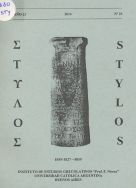Please use this identifier to cite or link to this item:
https://repositorio.uca.edu.ar/handle/123456789/4693| Título: | Fenómenos sublunares en Plinio y Séneca : identificación y traducción | Autor: | Anunziato, Alberto Daniel | Palabras clave: | Séneca, Lucio Anneo, 4 a.C.-65 d.C.; Plinio, El Viejo; ASTRONOMIA; ANTIGÜEDAD; TRADUCCION; ANALISIS TEXTUAL | Fecha de publicación: | 2014 | Editorial: | Universidad Católica Argentina. Facultad de Filosofía y Letras. Instituto de estudios grecolatinos "Prof. F. Nóvoa" | Cita: | Anunziato, Alberto. “Fenómenos sublunares en Plinio y Séneca : identificación y traducción” [en línea]. Stylos, 23 (2014). Disponible en: https://repositorio.uca.edu.ar/handle/123456789/4693 | Resumen: | Resumen: La identificación de los fenómenos considerados sublunares en la Antigüedad a partir de la terminología latina es particularmente dificultosa. Nuestra propuesta es considerar los términos que aparecen en las enumeraciones de Plinio y Séneca tomando como parámetro de referencia la nomenclatura astronómica moderna y como hipótesis la de que las observaciones antiguas, por personas de gran capacidad de observación en un cielo sin contaminación lumínica pueden compararse a las que podemos obtener hoy a través de la astrofotografía. La conclusión es que, dado que en la Antigüedad grecolatina cada fenómeno se reportaba con la misma fórmula descriptiva, es posible determinar la equivalencia entre los términos romanos y los actuales (cometas, meteoros, etc.), como paso previo a adoptar una decisión traductiva, ya sea que los consideremos términos científicos o culturalmente específicos. Abstract: The identification of the phenomena considered as sublunary in antiquity from the Latin terminology is particularly difficult. Our proposal is to consider the terms that appear in the enumerations of Pliny and Seneca taking as reference parameter modern astronomical nomenclature and as hypothesis that the antique observations by people of great power of observation in a sky without light pollution can be compared to those we can get today through astrophotography. The conclusion is that, since in Greco-Roman antiquity each phenomenon was reported with the same descriptive formula, it is possible to determine the equivalence between Romans and modern terms (comets, meteors, etc.) as step prior to a translational decision, whether we considered them as scientific or as culturally specific terms. |
URI: | https://repositorio.uca.edu.ar/handle/123456789/4693 | ISSN: | 0327-8859 | Disciplina: | LITERATURA | Derechos: | Acceso Abierto | Fuente: | Stylos, 23, 2014 |
| Appears in Collections: | STY - 2014 nro. 23 |
Files in This Item:
| File | Description | Size | Format | |
|---|---|---|---|---|
| fenomenos-sublunares-plinio-seneca.pdf | 321,24 kB | Adobe PDF |  View/Open |
Page view(s)
111
checked on Apr 27, 2024
Download(s)
98
checked on Apr 27, 2024
Google ScholarTM
Check
This item is licensed under a Creative Commons License

